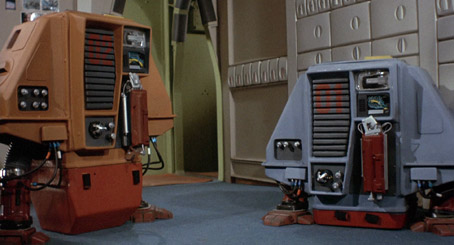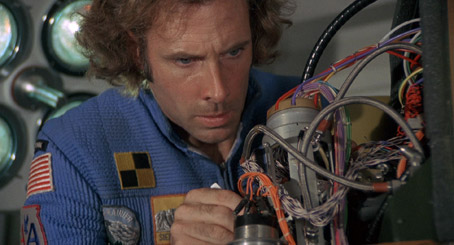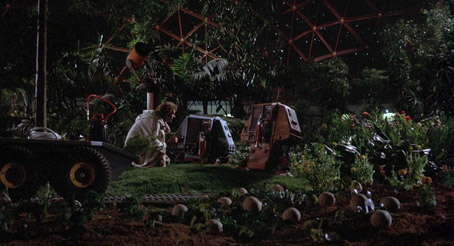| |
"I give my pledge as an American to save and faithfully defend from waste, the natural resources of my country – its soil and minerals, its forest, waters and wildlife... |
| |
The Conservation Pledge – set dressing
on the Valley Forge space ship Interior |
...and when necessary, commit murder to carry out said pledge."
Doesn't quite scan, that last amendment, does it? What are your ecological credentials? Do you use long-life bulbs, recycle as much as you can, switch off electrical kit at the wall at night? Small steps perhaps but small steps are better than no steps. What would you do to protect the natural world if all that's left of it resides in geodesic domes bolted to three vast space ships because Earth can no longer sustain them? Just how far would you go? Despite my memory of this extraordinary film being a teenage one, full of anti-corporation, anti-state thoughts, based on a recent re-viewing I revised my feelings just a smidgeon. Lowell Freeman is without question the hero of the movie but Silent Running is the story of a man who loves the natural world so much, he is prepared to kill to protect it. Now some of you are nodding your head thinking, "Yes, that's acceptable," and I'm thinking, maybe it's not that acceptable. Perhaps Silent Running is about a certifiable psychopath on a hopeless mission. Whatever your take on Freeman Lowell's actions, it's a question worth asking.

And for ambiguity in character (which is a damn fine thing) look no further than cinema's favourite nut-job, Bruce Dern. Yes, Christopher Walken may have inherited the mantle but Dern was the lone star original. He's such an interesting actor, wide-eyed innocence connected to a ferocity of purpose that makes him a great defender of the defenceless and a guy you wouldn't trust to pass you the scissors. As astronaut gardener Lowell Freeman, he is aided in his quest to keep the flora and fauna alive by director, Douglas Trumbull despite having nowhere to run to except deep space. One of the effects maestros on Kubrick's seminal 2001 A Space Odyssey a few years earlier, Trumbull was just twenty-eight when he set about bringing Lowell, his drones and domes to the screen. He's clearly from tree-hugging stock and there's no negative or positive spin on that term implied. The opening credits play out over some stunning macro photography, shots which almost drip honey especially at 1080p resolution. Here is, in your face, all we have left of the precious plant and animal life from our garbage planet now waiting for Wall-E to pick up the pieces.
The space ship Valley Forge is one of three transport ships keeping the greenery going while the astronauts await the word from Earth that it's ready to accept them back once the world returns to natural sustainability. It's clear from Dern's first costume, a monk like garment, that he is seen as a near religious defender of the faith (or in this case a little bunny rabbit). Dern does monomaniacal in his sleep and you know from his reactions to his granted unsympathetic shipmates that here is a volcano. Just when is it going to blow? To the three others on board, babysitting forests is not high on their agenda. They are Alien's Brett and Parker's antecedents, company men just wanting to get through the day and mission and back to Earth as soon as they can. They wilfully and literally ride roughshod over Lowell's efforts at tending his greenery and lightly tease his earnestness. These are not evil adversaries, just working men who may stand in Lowell's way. If you accept that Lowell has nowhere else to go with his precious cargo (except away from his home planet that is indifferent to his plight) then the men just become casualties of a very small war. What are a few domes of Earth's forests worth? How many human lives? The key to the movie is to see things from Lowell's perspective. If you're in space harbouring the jewel of Earth then as a species we're not really worth caring about. We have the collective responsibility of Republican Senators on vacation. In fact, the dread is that Silent Running may even be horribly prophetic. Scary.

The key memory that I – and many of my generation – have of Silent Running is of the wonderful, characterful 'drones', the automated robots programmed to take care of the menial duties on board ship. You are seeing the forerunners of R2D2, Wall-E and a whole host of non-sentimental versions of robots that science fiction filmmakers had hitherto failed to realise. Trumbull wanted a design that truly tested an audience's ingenuity. No human being could possibly fit inside these robot suits. The key of course was the strangely organic way in which they moved. The drones didn't glide or float from job to job. They walked on limbs that extended from their squat bodies. It's no secret how it was done but I'd rather not say if you're new to the film. The three drones (named after Donald Duck's nephews – Huey, Dewey and Louis) take on a strangely anthropomorphic life of their own. Their innate intelligence is programmed but for all intents, these are little friends of Lowell's and it's heartbreaking when two events render one lost and another essentially useless. They are more than "Just how did they do that?" special effects and do more to make Silent Running an intriguing and heartfelt movie than anything else, save Dern himself.
For its day, Silent Running was a special effects tour de force and still stands up forty years on. The model work has a grandeur to it that is significantly missing in today's penchant for speed and CG and at less than a tenth of 2001 A Space Odyssey's budget, Trumbull achieves much with very little. Most of the effects were achieved in camera with superb use of front projection. Obviously a technical wizard, Trumbull's real test on this project was his ability to partner his technical skill with character and dramatic smarts. Generously acknowledged by the director is the enormous help he got from a dedicated crew with the result that the film feels lovingly crafted and is never less than terrific to look at. The only small carp is that the film is edited at the correct pace for its time but today you may call it leisurely.
As small carps go, that's a tiddler. The only other dated aspect of the movie is its score. Trumbull was smart enough to want the desperately green and 60s icon Joan Baez and her music producer Peter Schickele's input. Schickele's score is lushly romantic and instantly identifiable after such a long period between viewings. That's a good thing but on a recent viewing I felt that the lushness was a little too lush. It gives gravitas to the ships and their cargo when my feeling was that we were looking at mankind's failure – something a little more (how shall I put this?) Ligeti in somber mood but as Kubrick got there first this is probably an idea Trumbull dismissed, rightly at the time, to distance his work from 2001. The two Joan Baez tracks may seem mawkish and overly sentimental now but they are as much a part of the movie's DNA as the forests themselves.

Trumbull employs a very effective editorial technique to address two key points in the film. So as not to dwell on a gruesome wound and the drone's subsequent medical help, the cuts in this scene are almost subliminal suggesting Dern's state of pain (and fractured mind). As robotic drones in 1971 didn't have the technology to perform these medical feats without recourse to effective editing, you might say that this type of montage was employed to cover up what the drones couldn't actually perform but that's a small detail. The same technique is used to allow the audience to identify with the measure of guilt that Dern has to deal with. Trumbull uses the same editorial technique to suggest Dern regrets what he had to do to save his precious forests. Despite their brief appearances, these shots go a long way to address a significant question, the one I posed earlier. How far would you go? They also mark Trumbull's credentials as a visual storyteller – not bad for a 28 year old. This classic science fiction eco-movie is a fascinating inclusion in the 'Masters Of Cinema' series and deserves to be more widely appreciated as such.
Presented in 1.85:1, Silent Running on Blu-ray looks just gorgeous. Blacks (oh so important in a space movie) are rendered black enough. I've been told by a good friend that there is a monitor/TV screen out there (the BVM-E 250) that costs thousands of Euros that shows black as black and doesn't actually emit light, just the movie without enhancement. I won't be buying one of those too soon. Regardless, the movie looks terrific and suits the Blu-ray format as if it was meant to be.
The DTS-HD Master Audio 2.0 is clear and mostly without hiss or noticeable distortion. There are subtitles for the deaf and hard of hearing. There's also an opportunity to isolate the music and effects track. Not sure how many even die-hard fans will take advantage of this extra.
Commentary Track
Director and star Trumbull and Dern do the reminiscing from a commentary recorded over a decade ago. What is charming is the mutual affection the two men still have for each other and the project. It infuses the commentary with passion and that's always a good sign. Trumbull outlines the extraordinary leeway granted to directors (after the success of Easy Rider) if they could bring their movie in for under a million dollars. The filmmakers were also awarded final cut, something unheard of by the major studios today. If only that bravery could be called back into play today. Dern talks about the 22 movies he had played in up to that point always cast as the oddball or dangerous character. Trumbull says of his star "What a sweet guy you are!" with no irony given his murderous treatment of his co-astronauts in the movie. But then Silent Running's precious commodities were always going to be the forests themselves. Trumbull remarks that he still has Dern's original outfit (perhaps an Ebay item if Trumbull ever runs short). The detail that stood out for me was Trumbull's explanation of how the stars were created in the movie. Just as in 2001, they were white paint splattered on black cardboard. Ah, the do-it-yourself detail of the pre-computer age. This is a tremendous commentary track, well worth a listen.

The Making of Silent Running (50' 00")
This extra was an utter joy, an inadvertent celebration of 'real' movie making when everything had to be figured out for real with no post production digital jiggery-pokery to act as a safety net. This extra reminded me a great deal of Vivian Kubrick's fly on the wall documentary made about her father's The Shining. It's down and dirty, shot on 16mm film, with the practical necessities of film-making front and centre. The details and travails of the production are lovingly documented. Bruce Dern not missing a day's running (on the real and decommissioned aircraft carrier 'Valley Forge'); real sets based on the actual control centre of the location; hangers big enough to house the dome contents; the temperature of the water in which Dern is expected to luxuriate. There's also a great deal about how the drones worked, both mechanically and physically. It's one of the most cheerfully revealing 'Making Ofs" I've had the pleasure to view. There is no studio interference (or no obvious studio interference) where the crew has to swear familial allegiance to their colleagues. It's just a smart and savvy filmmaking crew doing a great job.
Silent Running by Douglas Trumbull (30' 08")
The grading on this extra has the unfortunate effect of making Trumbull look Ooompa-Loompa-orange but I digress. Trumbull talks about learning from Kubrick (oh, to be a 26 year old in Kubrick's company at the height of his cinematic genius). He talks about the deal that was made to make several one million dollar budget movies (stay under that budget and you have creative control and final cut – extraordinary) due to the surprising result of Easy Rider's business. I'm surprised that Trumbull's inspiration for the drones was from Todd Browning's Freaks (seeing a classic work in terms of how to make your robots work strikes me as odd) but completely believable. Due to the low budget, Trumbull also admits to never taking more than three takes on any shot. This is really low budget filmmaking and you would never have guessed. There's a coda that I've not been able to glean any more information on despite the power of the web. This extra was dedicated to Ann Bolster Vidor. All I get from Google is: "No results..." Would be curious to find out who this woman is/was.
That was written before I heard the commentary. She was, of course, Trumbull's wardrobe advisor on the movie as well as his later and now sadly late wife.
Douglas Trumbull Then and Now (04' 51")
Trumbull unleashes his frustration over the scant recognition that his Back To The Future Ride received as a true cinematic experience (uh, it's a fairground ride but I think I know where he's coming from). He mourns the loss of photo-chemical film as a viable medium (specifically 70mm film – and I'll join him in that). He refers to his Future General company (ILM's precursor) and its patented 'Showscan' process, one that may get a 21st century reprieve from none other than James Cameron. This involves an overhaul of the worldwide projection systems (which is why it's so difficult to push forward) to upgrade projectors to show movies at 60 frames per second, over twice as much as traditional 35mm now projects at. Aren't these figures relatively meaningless in terms of digital projection or is there a way to 60 fps that can be done digitally? James Cameron obviously thinks so.

A Conversation with Bruce Dern (10' 56")
This is a genial chat with the actor behind Lowell Freeman, the incomparable Bruce Dern. He talks about typecasting and what a breath of fresh air it was to be offered the role of Freeman. Not sure how that works as Dern's reputation at that time was for playing villains and oddballs. How is Freeman the good guy in Silent Running? It depends on your perspective.
Trailer (02' 57")
"A cataclysm in outer space!" Joan Baez's specially written music stands front and centre in this early example of 70s trailer art. It also includes an advert for the Universal Studios Tour.
Isolated Music and FX audio track
Peter Schickele's lush score (sometimes overly so in my opinion) and the Joan Baez's songs are presented free from the shackles of sound effects and dialogue in pure DTS-HD MA 2.0 sound. I've never been a convert to this kind of 'Extra'. If you're that much of a fan you have the score to enjoy on other media to play on other components. Seems a bit odd to use the Blu-ray for just the music. It's like getting in a car just to hear the radio.
Lavish 48-page collector booklet
This beautifully presented 48 page 'Making of..." is a treasure trove of detail with some but very little overlap with the detail found on the Extras of the actual disc. It reminded me (and I can give no higher praise) of a specially themed edition of the magazine Cinefex, one of the best magazines out there (and one of the only ones) for those of us interested in special effects. The stills are many and revealing (somehow a paper presentation of this material feels much better than if they were a separate Extra to be clicked through on the disc). For my money this is the Extra of the whole disc (with some stiff competition from the "Making Of" feature).
Silent Running is one of the very first mainstream ecologically minded movies and its message is projected and forwarded by a certifiable loon played deliciously by Bruce Dern. The effects are first class and it wears its green heart on its spacesuit sleeve. Its only shortcoming from my point of view is its pace but there's more than enough to keep you riveted in performance, action and effects. It's a solid entry under the Masters Of Cinema banner.
|